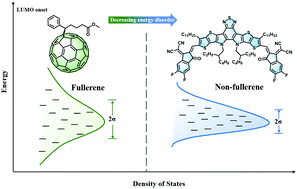Effects of energetic disorder in bulk heterojunction organic solar cells
Abstract
Organic solar cells (OSCs) have progressed rapidly in recent years through the development of novel organic photoactive materials, especially non-fullerene acceptors (NFAs). Consequently, OSCs based on state-of-the-art NFAs have reached significant milestones, such as ∼19% power conversion efficiencies (PCEs) and small energy losses (less than 0.5 eV). Despite these significant advances, understanding of the interplay between molecular structure and optoelectronic properties lags significantly behind. For example, despite the theoretical framework for describing the energetic disorder being well developed for the case of inorganic semiconductors, the question of the applicability of classical semiconductor theories in analyzing organic semiconductors is still under debate. A general observation in the inorganic field is that inorganic photovoltaic materials possessing a polycrystalline microstructure exhibit suppressed disorder properties and better charge carrier transport compared to their amorphous analogs. Accordingly, this principle extends to the organic semiconductor field as many organic photovoltaic materials are synthesized to pursue polycrystalline-like features. Yet, there appears to be sporadic examples that exhibit an opposite trend. However, full studies decoupling energetic disorder from aggregation effects have largely been left out. Hence, the potential role of the energetic disorder in OSCs has received little attention. Interestingly, recently reported state-of-the-art NFA-based devices could achieve a small energetic disorder and high PCE at the same time; and interest in this investigation related to the disorder properties in OSCs was revived. In this contribution, progress in terms of the correlation between molecular design and energetic disorder is reviewed together with their effects on the optoelectronic mechanism and photovoltaic performance. Finally, the specific challenges and possible solutions in reducing the energetic disorder of OSCs from the viewpoint of materials and devices are proposed.



 Please wait while we load your content...
Please wait while we load your content...